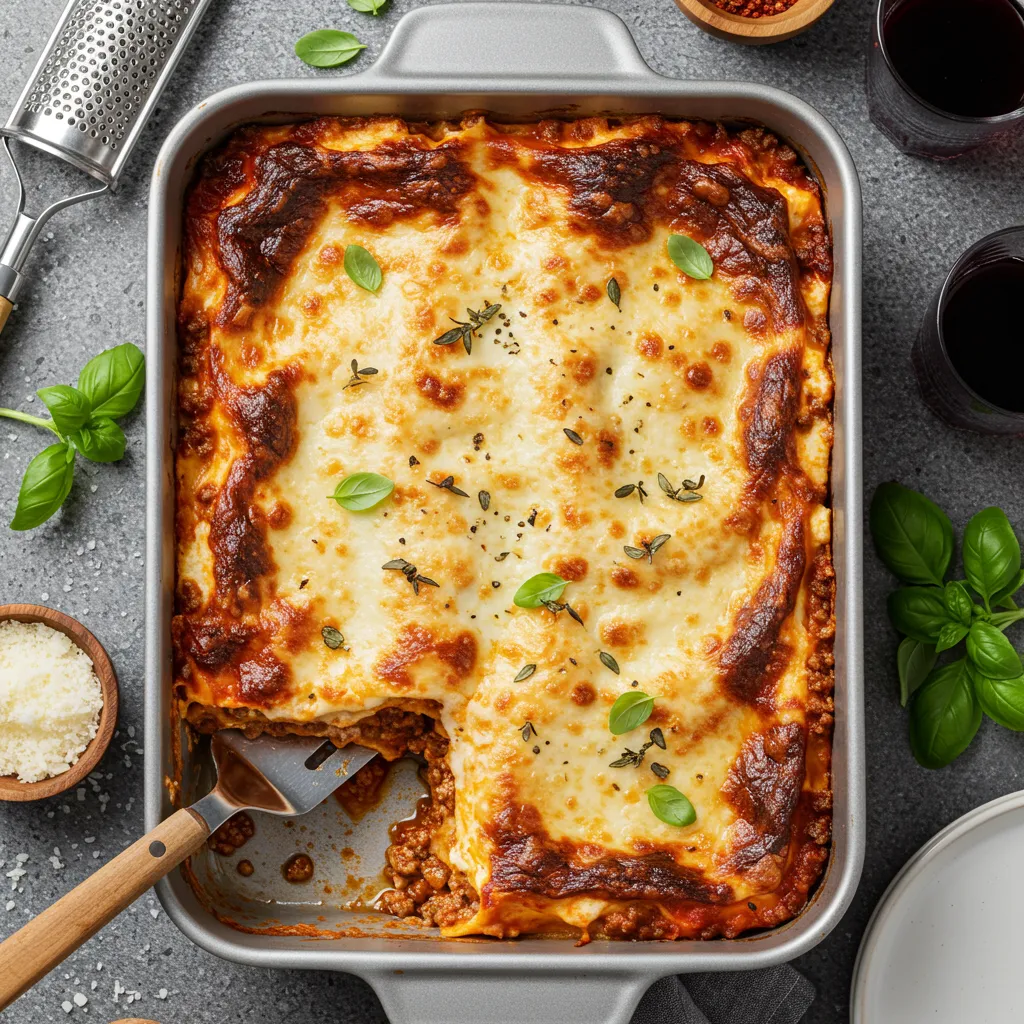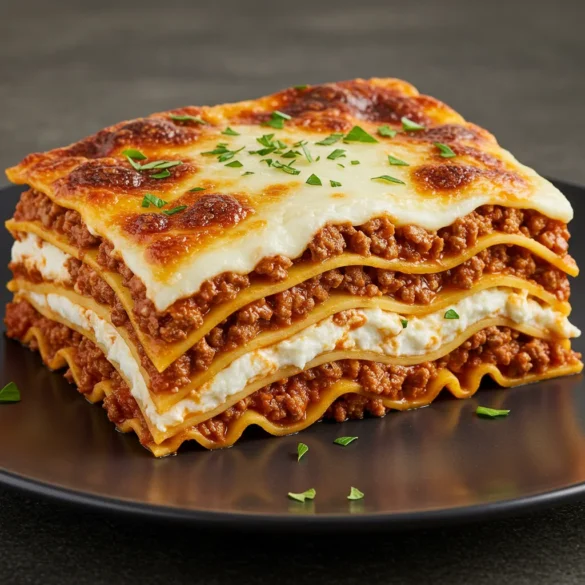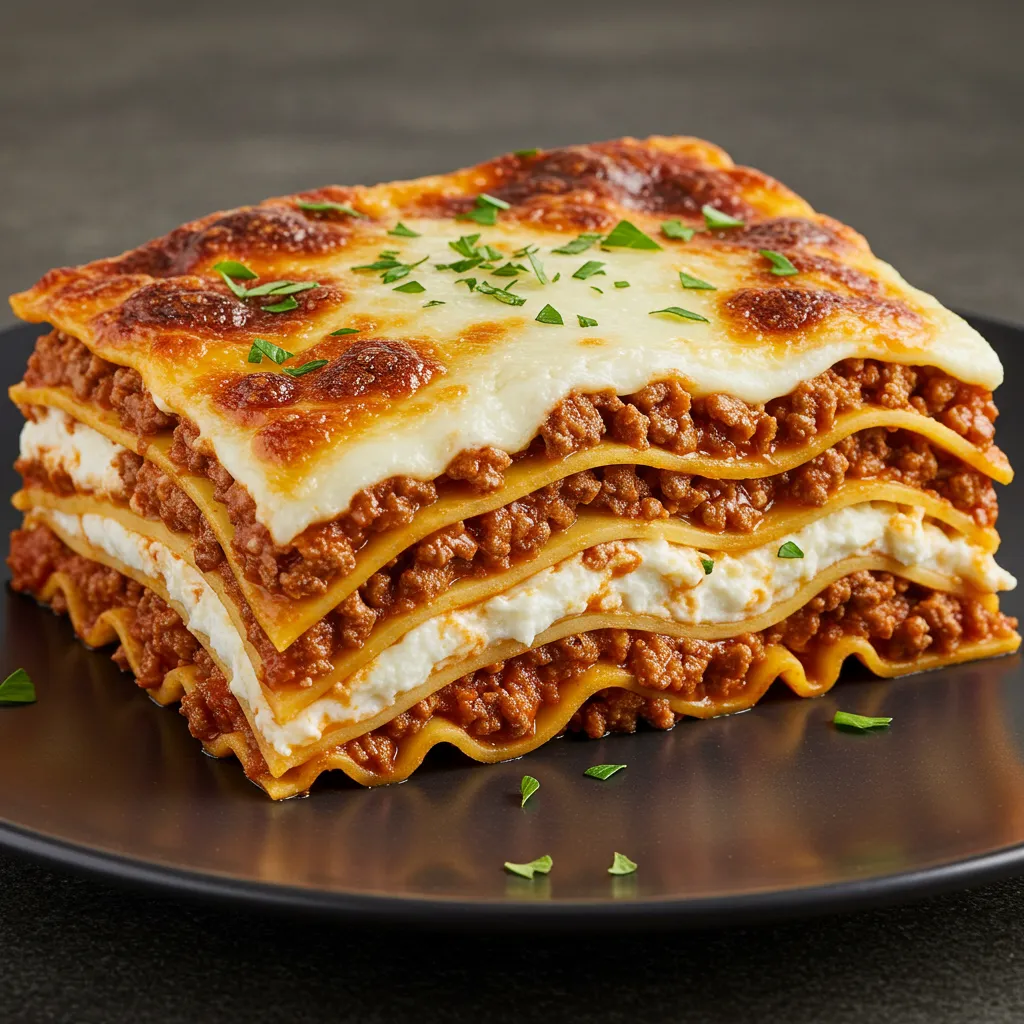This sumptuous Classic Beef and Ricotta Lasagna delivers the ultimate comfort food experience with its layers of tender pasta sheets, rich meat sauce, and creamy cheese blend. The golden, bubbly mozzarella top creates an irresistible crown for the flavorful layers beneath, while fresh herbs add a bright finishing touch. Each slice reveals the perfect marriage of savory beef, tangy tomato sauce, and creamy ricotta filling—a hearty, satisfying meal that has stood the test of time as a family favorite. Ideal for Sunday dinners, potluck gatherings, or whenever you crave a comforting, make-ahead meal that’s worth every minute of preparation.
Why You’ll Love This Recipe
- Crowd-pleasing classic: A time-tested favorite that appeals to almost everyone
- Make-ahead friendly: Can be assembled days in advance and freezes beautifully
- Impressive presentation: Creates a stunning visual when served at the table
- Versatile: Can be adapted with different ingredients based on preferences
- Perfect for gatherings: Feeds a crowd and often tastes even better the next day
- Complete meal: Contains protein, carbohydrates, and vegetables in one dish
- Restaurant-quality: Achieve professional results in your home kitchen
- Customizable: Easy to adjust for dietary needs or available ingredients
Ingredients
For the Meat Sauce
- Ground beef – Provides rich, savory flavor and hearty texture
- Italian sausage – Adds depth and subtle spices to complement the beef
- Onion and garlic – Create an aromatic foundation for the sauce
- Crushed tomatoes – Form the base of the sauce with bright acidity
- Tomato paste – Concentrates the tomato flavor and thickens the sauce
- Italian herbs – Dried oregano, basil, and thyme create authentic Italian flavor
- Red wine – Adds complexity and helps tenderize the meat
- Bay leaves – Contribute subtle depth to the long-simmered sauce
- Salt and pepper – Balance and enhance all other flavors
For the Cheese Filling
- Ricotta cheese – Creates a creamy, tender layer between the pasta and sauce
- Mozzarella cheese – Provides the classic melty, stretchy texture
- Parmesan cheese – Adds sharp, nutty flavor that cuts through the richness
- Eggs – Bind the ricotta filling and help it set during baking
- Parsley – Offers fresh, herbaceous notes and visual appeal
- Nutmeg – A traditional secret ingredient that enhances cheese flavors
For Assembly
- Lasagna noodles – Traditional flat pasta sheets that create the foundation
- Olive oil – Prevents noodles from sticking after cooking
- Additional mozzarella – Creates the golden, bubbly top layer
- Fresh herbs – Parsley or basil for garnish adds color and freshness
Step-by-Step Instructions
Preparing the Meat Sauce
Begin by heating 2 tablespoons of olive oil in a large, heavy-bottomed pot over medium heat. Add 1 large diced onion and cook until translucent, about 5 minutes. Add 4 minced garlic cloves and cook for an additional 30 seconds until fragrant, being careful not to burn the garlic.
Increase the heat to medium-high and add 1 pound of ground beef and 1/2 pound of Italian sausage (casings removed). Cook until browned, breaking the meat into small pieces with a wooden spoon, about 8 minutes. Drain excess fat if necessary, leaving about 1 tablespoon for flavor.
Pour in 1/2 cup of dry red wine, scraping the bottom of the pot to release any browned bits. Allow the wine to reduce by half, about 3 minutes.
Add 2 cans (28 ounces each) of crushed tomatoes, 2 tablespoons of tomato paste, 2 teaspoons of dried oregano, 1 teaspoon of dried basil, 1/2 teaspoon of dried thyme, 2 bay leaves, 1 teaspoon of salt, and 1/2 teaspoon of black pepper. Stir to combine.
Bring the sauce to a simmer, then reduce heat to low. Cover partially with a lid and cook for 1 to 1.5 hours, stirring occasionally, until the sauce is rich and slightly thickened. The longer cooking time allows the flavors to meld and develop complexity.
Taste and adjust seasonings as needed. Remove bay leaves before using the sauce for assembly. If time permits, allow the sauce to cool slightly before assembling the lasagna, as it will be easier to handle.
Making the Cheese Filling
While the sauce simmers, prepare the cheese filling. In a large mixing bowl, combine 2 pounds of whole milk ricotta cheese, 2 large eggs, 1/2 cup of chopped fresh parsley, 1 cup of freshly grated Parmesan cheese, 1 teaspoon of salt, 1/2 teaspoon of black pepper, and a pinch of ground nutmeg.
Mix thoroughly until all ingredients are well incorporated and the mixture is smooth. Cover and refrigerate until ready to use.
Preparing the Pasta
Bring a large pot of salted water to a boil. Cook 1 pound of lasagna noodles according to package instructions, usually about 8-9 minutes for al dente. It’s important not to overcook the pasta, as it will continue to soften during baking.
When the noodles are cooked, drain them and rinse under cold water to stop the cooking process. Toss gently with a drizzle of olive oil to prevent sticking, then lay them flat on clean kitchen towels or baking sheets until ready to assemble.
Assembling the Lasagna
Preheat your oven to 375°F (190°C). Lightly grease a deep 9×13-inch baking dish with olive oil or cooking spray.
Spread 1 cup of meat sauce evenly across the bottom of the baking dish. This prevents the pasta from sticking to the dish and burning during baking.
Arrange a layer of lasagna noodles over the sauce, slightly overlapping them to cover the entire surface. Trim the noodles if necessary to fit the dish.
Spread approximately 1/3 of the ricotta mixture over the noodles, using an offset spatula to create an even layer that reaches all edges. This creamy layer provides a nice contrast to the meaty sauce.
Sprinkle 1 cup of shredded mozzarella cheese over the ricotta layer, distributing it evenly.
Pour approximately 1.5 cups of meat sauce over the cheese, spreading it to cover the entire surface.
Repeat the layering process—noodles, ricotta mixture, mozzarella, and meat sauce—two more times, for a total of three complete layers.
For the final layer, arrange the remaining noodles on top, spread the remaining meat sauce over them, and cover completely with 2 cups of shredded mozzarella cheese and 1/4 cup of grated Parmesan cheese.
Baking and Serving
Cover the baking dish with aluminum foil, tenting it slightly so it doesn’t touch the top layer of cheese. This prevents the top from browning too quickly while the interior heats through.
Place the lasagna on the middle rack of the preheated oven and bake for 25 minutes. Then remove the foil and continue baking for an additional 25 minutes, until the cheese is bubbly and golden brown in spots.
For an extra golden top, you can place the dish under the broiler for 1-2 minutes, watching carefully to prevent burning.
Once baked, remove the lasagna from the oven and let it rest for at least 15 minutes before serving. This crucial resting period allows the layers to set and makes it much easier to cut neat portions.
Garnish with additional fresh chopped parsley or basil just before serving for a burst of color and fresh flavor.
Cut into generous squares and serve warm, revealing the beautiful layers of pasta, sauce, and cheese that make lasagna such a beloved dish.

Pro Tips
- Allow your meat sauce to simmer for at least an hour for the best flavor development
- Use whole milk ricotta and mozzarella for the creamiest texture and best melt
- Let your lasagna rest for 15-20 minutes after baking for cleaner slices
- Cook lasagna noodles just until al dente, as they’ll continue cooking in the oven
- Layer meat sauce on the bottom of the pan first to prevent noodles from sticking
- Use freshly grated Parmesan rather than pre-grated for better flavor and melting
- Season each component well—the pasta, sauce, and cheese filling all need proper seasoning
- For the best texture, don’t skip the eggs in the ricotta mixture
- Cover with foil for the first half of baking to prevent over-browning
- Use a deep baking dish to accommodate all the layers without overflow
Variations and Creative Ideas
Flavor Variations
Spinach and Mushroom: Add 2 cups of sautéed mushrooms to the meat sauce and mix 10 ounces of thawed, well-drained frozen spinach into the ricotta filling for added vegetables and earthy flavor.
Spicy Arrabbiata: Incorporate 1 teaspoon of red pepper flakes into the meat sauce and use spicy Italian sausage instead of mild for a zesty kick that complements the creamy cheese.
White Lasagna: Replace the tomato-based meat sauce with a béchamel sauce and add sautéed chicken, creating an elegant variation with a velvety texture and delicate flavor profile.
Pesto Infusion: Mix 3 tablespoons of basil pesto into the ricotta filling and drizzle additional pesto between layers for a fragrant, herbaceous twist on the classic recipe.
Protein Options
Turkey or Chicken: Substitute ground turkey or chicken for beef for a lighter option that still provides hearty texture and absorbs the sauce flavors beautifully.
Vegetarian: Replace meat with a robust mixture of sautéed zucchini, eggplant, bell peppers, and mushrooms for a garden-fresh version packed with texture and flavor.
Seafood: Create a coastal-inspired variation with a mixture of shrimp, scallops, and crab meat in a light tomato sauce with a hint of white wine and saffron.
Lentil and Walnut: Combine cooked lentils and finely chopped walnuts for a vegetarian protein option that provides a satisfying texture and earthy depth.
Dietary Adaptations
Gluten-Free Option: Use certified gluten-free lasagna noodles or thinly sliced zucchini or eggplant as pasta replacements for those with gluten sensitivities.
Dairy-Free Adaptation: Substitute traditional cheeses with dairy-free alternatives made from nuts or plant-based ingredients, available at most specialty grocery stores.
Lower Carb Version: Replace pasta sheets with thinly sliced zucchini or eggplant, reducing carbohydrates while maintaining the layered texture and hearty flavor.
High Protein Option: Add an extra pound of meat to the sauce and incorporate cottage cheese into the ricotta mixture for additional protein content.
Storage and Make-Ahead Advice
Refrigerator Storage: Cover baked lasagna tightly with foil or transfer cut portions to airtight containers. Refrigerate for up to 4 days, with flavor often improving after the first day as ingredients meld.
Freezer Storage:
- Baked lasagna can be frozen in its entirety or as individual portions for up to 3 months. Cool completely before wrapping tightly in foil and plastic wrap to prevent freezer burn.
- For unbaked lasagna, assemble completely, cover tightly with plastic wrap and foil, and freeze for up to 2 months. Thaw in refrigerator before baking.
- Individual frozen portions can be reheated directly from frozen, making them perfect for quick weeknight meals.
Make-Ahead Options:
- Prepare the meat sauce up to 3 days in advance and refrigerate, or freeze for up to 3 months.
- Assemble the entire lasagna up to 24 hours before baking. Cover and refrigerate, then allow to sit at room temperature for 30 minutes before baking.
- For best results when making ahead, slightly undercook the pasta as it will continue to absorb moisture while refrigerated.
- The cheese mixture can be prepared 1 day ahead and refrigerated in an airtight container.
Reheating Tips:
- Reheat individual portions in the microwave for 2-3 minutes or until heated through.
- For whole lasagna, cover with foil and reheat in a 350°F oven for 20-30 minutes, removing the foil for the last 5-10 minutes to re-crisp the top.
- Add a few tablespoons of water around the edges before reheating to prevent drying out.
- For the best texture when reheating frozen lasagna, thaw overnight in the refrigerator first.
Kid-Friendly Involvement
This recipe offers numerous opportunities for children to participate in the kitchen:
Layering Components: Children can help layer the noodles, sauce, and cheese, turning assembly into a fun building activity.
Measuring Ingredients: Kids can measure the herbs and spices for the sauce and cheese filling, developing their math skills.
Mixing the Cheese: Let children combine the ricotta mixture ingredients, which is tactile and enjoyable while teaching them about ingredient incorporation.
Grating Cheese: Older children can help grate mozzarella and Parmesan cheeses using a box grater (with supervision).
Seasoning Adjustments: Involve kids in tasting the sauce (once cooled) and deciding if it needs more herbs or seasoning, building their palate development.
Learning Opportunity: Explain the concept of layering flavors and textures while assembling, introducing culinary concepts in an accessible way.
Frequently Asked Questions
Do I need to boil the noodles before assembling the lasagna? Traditional recipes call for boiling the noodles first, but you can use no-boil lasagna noodles to save time. If using regular noodles without pre-boiling, add 1/4 cup of water around the edges of the dish before baking and ensure your sauce is slightly thinner than usual.
Can I make this lasagna without ricotta cheese? Yes, you can substitute ricotta with cottage cheese (drained and blended for smoothness), béchamel sauce, or a combination of cream cheese and sour cream for a different but equally delicious texture.
Why is my lasagna watery when I cut into it? Excess moisture typically comes from wet ingredients like ricotta or vegetables. Make sure to drain ricotta well, thoroughly cook vegetables to release moisture, and allow the finished lasagna to rest for at least 15 minutes before cutting.
Can I assemble this lasagna the day before baking? Absolutely! Assemble completely, cover tightly with plastic wrap or foil, and refrigerate for up to 24 hours. Allow it to sit at room temperature for 30 minutes before baking, and you may need to add 10-15 minutes to the covered baking time.
How can I prevent the top layer of pasta from becoming crispy or hard? Always ensure the top layer of pasta is completely covered with sauce before adding the final cheese layer. The sauce provides moisture that keeps the pasta tender during baking.

Ingredients
For the Meat Sauce:
- 1 pound ground beef (85% lean)
- 1/2 pound Italian sausage, casings removed
- 1 large onion, finely diced
- 4 garlic cloves, minced
- 2 cans (28 ounces each) crushed tomatoes
- 2 tablespoons tomato paste
- 1/2 cup dry red wine
- 2 teaspoons dried oregano
- 1 teaspoon dried basil
- 1/2 teaspoon dried thyme
- 2 bay leaves
- 1 teaspoon salt
- 1/2 teaspoon black pepper
- 2 tablespoons olive oil
For the Cheese Filling:
- 2 pounds whole milk ricotta cheese
- 2 large eggs
- 1/2 cup fresh parsley, chopped
- 1 cup Parmesan cheese, freshly grated
- 1 teaspoon salt
- 1/2 teaspoon black pepper
- Pinch of ground nutmeg
For Assembly:
- 1 pound lasagna noodles
- 4 cups mozzarella cheese, shredded and divided
- 1/4 cup Parmesan cheese, freshly grated (for topping)
- 2 tablespoons olive oil (for noodles)
- 1/4 cup fresh parsley or basil, chopped (for garnish)
Instructions
Prepare meat sauce by sautéing onions and garlic, then browning meat.
Add wine, tomatoes, paste, and seasonings; simmer 1-1.5 hours.
Mix ricotta with eggs, parsley, Parmesan, salt, pepper, and nutmeg.
Cook lasagna noodles until al dente; toss with olive oil to prevent sticking.
Spread 1 cup sauce in baking dish, then layer: noodles, ricotta, mozzarella, sauce.
Repeat layers twice more, finishing with noodles, sauce, and remaining cheese.
Cover with foil and bake at 375°F for 25 minutes.
Remove foil and bake 25 minutes more until bubbly and golden.
Rest 15 minutes before garnishing with fresh herbs and serving.
Notes
- Brown the meat in batches to ensure proper caramelization rather than steaming
- Taste your sauce before assembly and adjust seasonings—it should be slightly more seasoned than you think necessary
- Cool your meat sauce slightly before assembly to prevent it from making the ricotta mixture too runny
- Place a baking sheet on the rack below your lasagna to catch any potential overflow
- Use an offset spatula for the most even distribution of ricotta filling
- Cut lasagna with a sharp knife, wiping the blade clean between cuts for the neatest presentation
- For a more uniform look, grate your own mozzarella instead of using pre-shredded
- When making ahead, slightly under-season the sauce as flavors will intensify over time
- For the best flavor, bring refrigerated lasagna to room temperature before baking
- Add a sprinkle of red pepper flakes between layers if serving adults who enjoy a subtle heat
- For extra richness, dot each ricotta layer with small pieces of fresh mozzarella in addition to the shredded cheese

